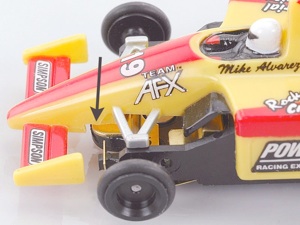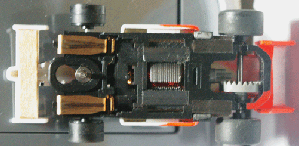G-Jet National Rules (last updated in 2019)
1. Cars eligible to compete in this class include the BSRT G-Jet® and Formula G-Jet®.
2. The chassis must be a stock BSRT G3-R® Flexible chassis with Flexible traction weight clip. The front axle holes may be reamed to .052”. Stock body tube holes that have been previously threaded are allowed. No other modifications are allowed.
3. Motor magnets must be BSRT #290 G-Force™ C4 Ceramic-Grade and cannot be modified. Magnets must remain in stock position.
4. Armature must be a stock BSRT G-Jet®, narrow gap design, and be a minimum of 9-ohms. BSRT G-Jet® 9-ohm Hot Stock™ armature may be substituted for the stock unit.
5. Armature bushings must be stock or BSRT stock replacement (no ball bearings). Bushings may be reamed, chamfered, and polished.
6. All electrical system parts must be stock or BSRT stock replacement. Twisted brush endbells are not allowed
7. G-Jet® Front End: front axle and non-independent G-Jet® #878 rims and O-ring front tires must be stock and unmodified. Front O- rings must be a minimum tire diameter of .350”. In G-Jet®, front axle assembly must be installed using the short wheelbase location.
Formula G-Jet® Front End: front axle and non-independent Formula G-Jet® #877 rims and #950 front tires must be stock and unmodified. In Formula G-Jet®, front axle assembly must be installed using the long wheelbase location.
8. Rear tires must be BSRT #880 HPS™ Black Injection-Molded Silicone slip-on tires on BSRT #879 HPS Double-Flange Rear Rims. Minimum rear tire diameter must be .450″. The rear axle must be stock or BSRT stock replacement. Front and rear rims cannot be modified.
9. BSRT G-Jet® handling weights must be used. Weights must be used in their stock location. Weights may not be modified.
10. Gears must be stock or BSRT stock replacement. Gears may not be lightened. Axle spacers may be used to aid with gear mesh.
11. The guide pin must be stock or BSRT stock replacement in the stock position.
12. Glues/adhesives are not allowed on the chassis except to retain the guide pin.
13. The body in Formula G-Jet® must be a Tomy snap in place stock Formula injection-molded body. The weight of the body may not be less than 2.1 grams. All wings must be secured to the body. The front wings may be repaired/reinforced using styrene by removing a small amount of plastic under the front wing. A very small amount of plastic may be removed on the body nose to allow for clearance of the front Formula G-Jet weight. Rear adjustable wing flap must be glued into fixed position. All bodies must be painted.
14. G-Jet® races shall be run at 12.0 volts +/- .25 volts.
Formula G-Jet
The “Formula G-Jet” car is based on the long wheelbase version of the G3 chassis which allows the use of Tomy AFX snap-on Formula bodies. This G-Jet features wide front tires to get the realistic look of a true Formula car. Any Formula body that fits a Super G-Plus car will also fit the Formula G-Jet.
The G-Jet National Rules apply with the following modifications:
Front Handling Plate
The BSRT “Formula G-Jet” front handling plate must be the .020 weight part #887. This allows clearance for the front axle assembly to be placed in the long wheel base position.
The plate must be used with the standard handling plate holder part #885 with 0-80 brass screw. Loctite may be used on the screw.
If using the light (.120”) traction weights, the BSRT traction weight spacers with a minimum thickness of .045” must be used.
Front Rim and Tire
The BSRT “Formula G-Jet” front axle assembly and rubber tire, part #877, must be installed using the front, long wheelbase hole.
Body
The body in Formula G-Jet® must be a Tomy SG+ snap in place stock Formula injection-molded body. The weight of the body may not be less than 2.1 grams. All wings must be secured to the body. The front wings may be repaired/reinforced using 1/32″ styrene plastic or plywood by removing a small amount of plastic under the front wing. A very small amount of plastic may be removed on the body nose to allow for clearance of the front Formula G-Jet front weight. Rear adjustable wing flap must be glued into fixed position. All bodies must be painted.
Parts needed to convert a standard G-Jet to a Formula G-Jet:
#887 – “Formula G-Jet” .020″ Brass Handling Plate
#877 – “Formula G-Jet” Front Axle Assembly
Tomy SG+ F1/Indy body
Note: the “Formula G-Jet” is available from BSRT as a rolling chassis; part #915F.
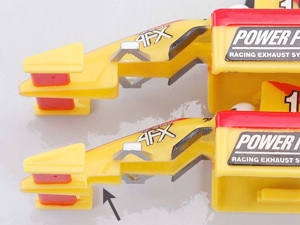
Lexan G-Jet
Short wheelbase only. The club currently runs three body classes for the Lexan G-Jet: Le Mans sports cars, Trans Am, NASCAR
Full-Width Hard Body G-Jet
Short wheelbase only. The club currently runs two body classes for the Full-Width Hard Bdy G-Jet:
Tomy Ford GT-40
Stock Tomy Ford GT-40 bodies
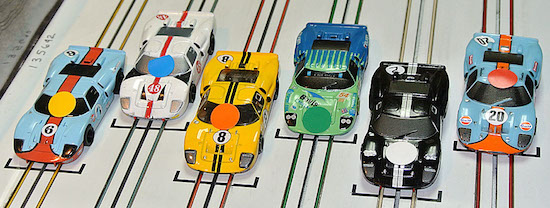
Aurora AFX “IMSA” Sports Cars
Original AFX bodies as an “IMSA” class. These bodies are based, to a large extent, on street cars that were seen here in the U.S. and should be a lot of fun to run with the G-Jet. The racer can choice any one of four different bodies. They are all roughly the same weight and are competitive together, should be plentiful and easy to find, and amenable to painting and detailing. This is an excellent opportunity to mate vintage Aurora bodies to the contemporary G-Jet platform.
Rules set for these bodies:
1. Four original Aurora AFX bodies are allowed in the IMSA class: Greenwood Corvette GT, Porsche 934 Turbo, Chevy Monza GT, BMW 320i Turbo.
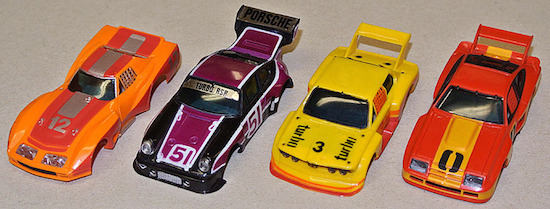
AFX Bodies: Greenwood Corvette GT, Porsche 934 Turbo, BMW 320i Turbo, and Chevy Monza GT.
2. The minimum weight for this body class is 4.2 grams (4.4 grams with glued-in body clip). Any body that is heavier than 4.2 grams can be modified to get down to the minimum weight. This is especially helpful for any painted bodies, which tend to weigh more than the stock bodies. Weight can be removed on the underside of the body only and may include slight trimming of the wheel wells. No holes or openings in the body are permitted. As a starting point, below are the typical weights for the bodies in stock form:
Greenwood Corvette – 4.2 grams
BMW 320i Turbo – 4.5
Chevy Monza – 4.6
Porsche 934 – 4.6
3. The only “odd” body in the IMSA class is the Greenwood Corvette because of the variations you can find on the body. The photos below show a top and bottom view of the two Corvette variations that come in at about 4.2 grams. One version has an extra piece of plastic at the back end of the body which, on an AFX slot car, housed a rear light. On the other version, there is an extra piece of plastic which served as a facsimile of front headlights on the real car (it doesn’t have the extra plastic at the rear). These are the two versions of the Corvette permitted.
You can find two other versions of the Greenwood Corvette which are either too light (no front headlight detail and no rear piece of extra plastic) or two heavy (both headlights and rear piece of plastic). The lighter version is not permitted since it is significantly lighter than the other three IMSA bodies. The heavier Corvette can be run but comes in around 4.8 grams which puts it at a disadvantage.
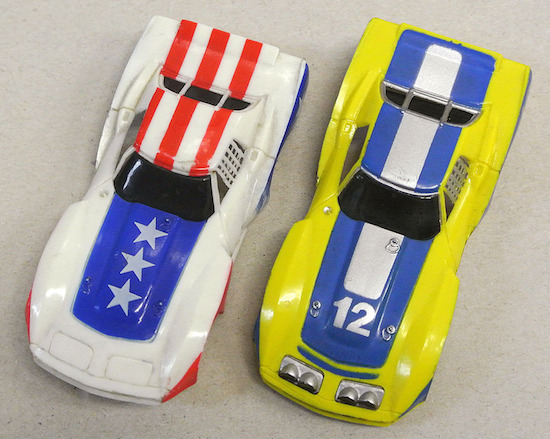
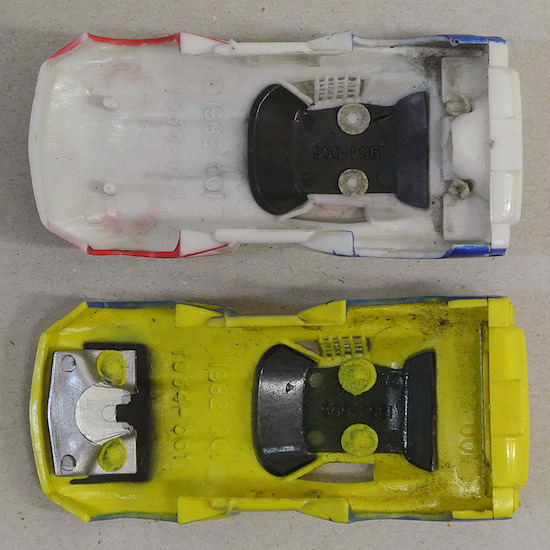
Front to back rocking with the AFX IMSA bodies on the G-Jet chassis.
The rocking is usually a combination of the body being able to move around on the clip as well as the clip moving around a bit when snapped onto the chassis. Most racers glue the clips to the bodies, which eliminates a lot of the rocking. Some will add a thin piece of styrene to the part of the clip that goes into the chassis as well. This allows you to adjust the “rock” on the body to be tight or loose.
Body weight issues
One option to make the 4.2 gram weight limit is to add ballast to the body should it need just a bit (like the Corvette), and one technique is to use a clear coat paint to get a light body up to the minimum weight. Racers have even been known to dip their bodies in Future Floor Wax to get them up to weight.
Yes, the Greenwood Corvette bodies are a bit of a problem especially since there are at least three different versions of the same body. Some bodies will make the weight limit and those that are too light must be painted, clear coated or have ballast added in other ways or another body will have to be used.
Body clip glued to the body
The set minimum weight is for just the body alone. A racer may decide to glue the body clip into the body to help with front to back rocking. The body clip weight is around 0.4 grams. Racers can cut down the size of the body clip, and the minimum you can get the clip down to is right around 0.2 grams.
So in tech, the minimum weight for the IMSA class of 4.2 grams is for the body only. If the body presented for tech has the clip glued in place the body would have to weigh a minimum of 4.4 grams.
Le Mans Group C
These would be the Japanese bodies from the late 1990s; Silk cut Jaguar, Group 44 Jaguar, Castrol Jaguar, Saube Mercedes, Circuit Board Mercedes etc. The racer can choice any one of the different bodies depicted in the photo below.
Rules set for these bodies:
1. These are the bodies to choose from for the Le Mans Group C class:

2. The minimum weight for this body class is 4.2 grams (4.4 grams with glued-in body clip). Any body that is heavier than 4.2 grams can be modified to get down to the minimum weight. This is especially helpful for any painted bodies, which tend to weigh more than the stock bodies. Weight can be removed on the underside of the body only and may include slight trimming of the wheel wells. No holes or openings in the body are permitted.
NASCAR Classes: Late Model (Tomy AFX) and Vintage (Aurora AFX)
Tomy AFX NASCAR stock cars
Chevrolet Monte Carlo
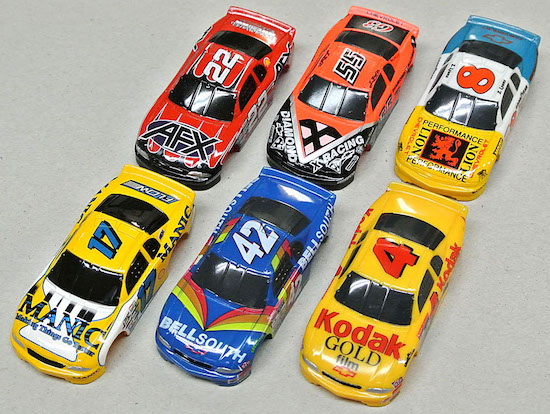
Ford Thunderbird
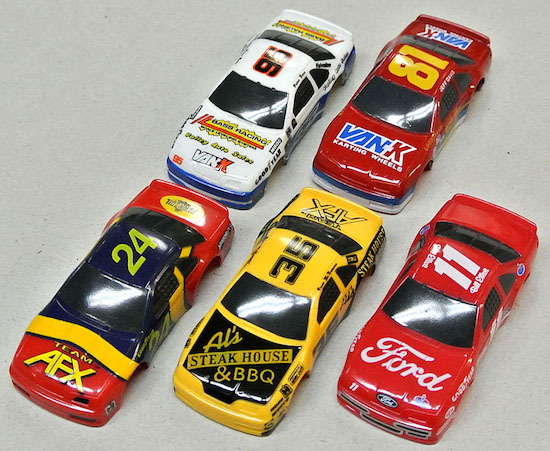
The only rules for the Tomy AFX NASCAR bodies would be a minimum weight or 4.5 or 4.6 grams, and no extensive hacking of the bodies. Below are weights for some of the bodies shown but, basically, they’re all within a pretty tight range.
9301-B Kodak Monte Carlo – 4.66 grams
9302-B Bell South Monte Carlo – 4.58 grams
9873-B VanK #95 Ford T-Bird – 4.70 grams
9881-B VanK #81 Ford T-Bird – 4.60 grams
9882-B AFX Ford T-Bird – 4.69 grams
Racers are encouraged to custom paint real NASCAR paint schemes, and in this case racers can remove some of the rear bumper or other logical place to get down to the minimum weight.
Aurora AFX NASCAR stock cars
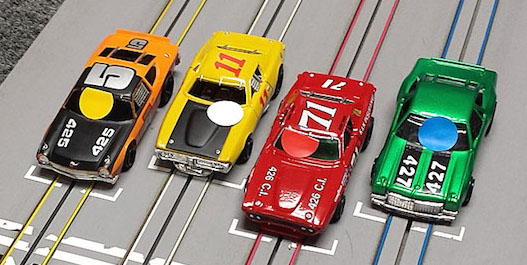
The Vintage NASCAR body class is snap-on bodies before the existence of the current Tomy and Auto World bodies. This means Aurora AFX, Magna-Traction, and possibly the original Tomy Super G+ bodies. Below are weights for some the bodies. A minum weight would need to be determined. Standard SWB G-Jets only.
AFX Matador (old) – 4.69
AFX Matador (new) – 4.74
Super G+ Charger – 3.91
AFX Mercury – 3.91
AFX Chevelle – 4.77
Possible future Full-Width Hard Body G-Jet Classes:
Porsche 962
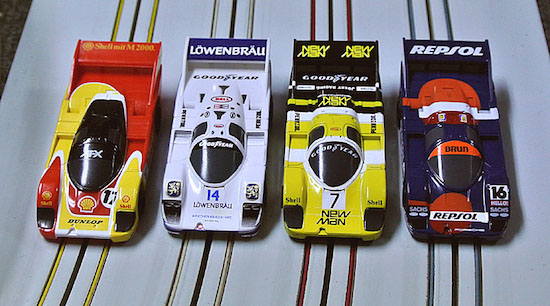
Instructional Videos
BSRT G3 Disassembly – Gary Beedle
BSRT G3 Assembly – Gary Beedle
